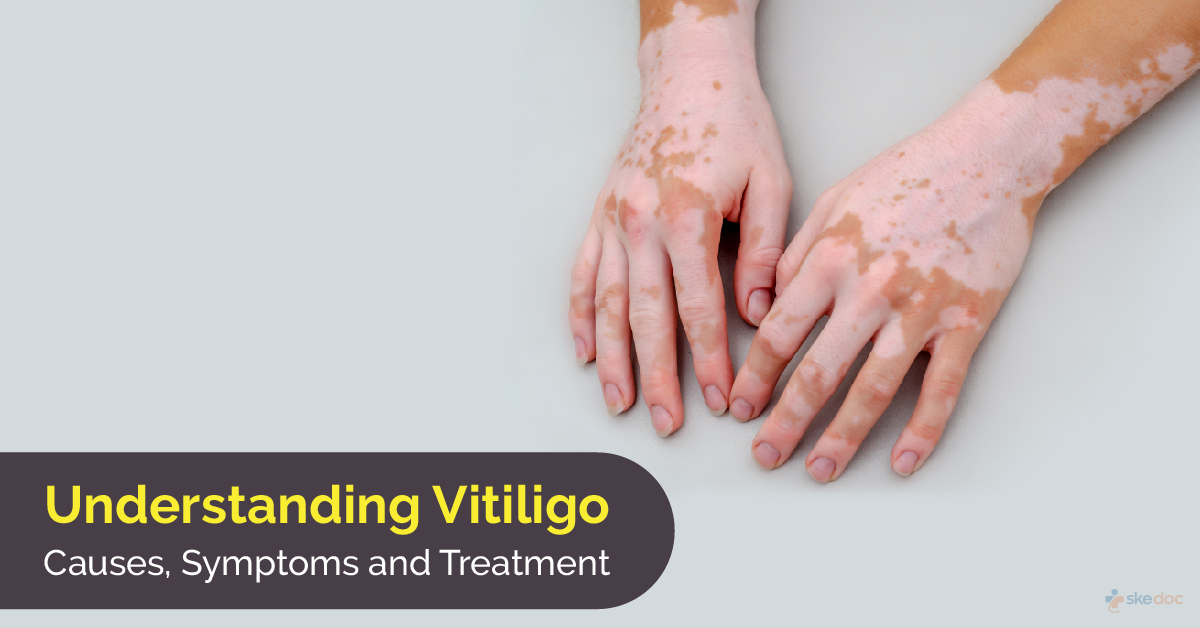Allergy
Blood Diseases
Bone & Joints
Brain
Cancer
Child Care
Cosmetic Surgery
Diabetes
Endocrinology
ENT
Eye
Gen Medicine
General Surgery
Heart
Kidney
Lifestyle
Liver & Digestive
Lung
Men’s Health
Mental health
Physiotherapy
Rheumatology
Skin and hair
Sleep Disorders
Spine
Transplant
Women Health
Thyroid
Vascular Surgery
Vitiligo

What is Vitiligo?
Vitiligo is a commonly seen condition in which areas of skin lose their pigmentation, resulting in white patches. It is a non-contagious condition that can occur at any age and primarily affects the skin of the face, hands, feet, and genitals. White patches disease can affect any race or ethnicity, and it tends to be more noticeable in people with darker skin.
Alternate name
White patch disease
Is Vitiligo a medical emergency?
Vitiligo is not a medical emergency.
Types
Vitiligo may be of the following types depending on the body area affected
- Segmental vitiligo
- Non-segmental vitiligo
- Generalized vitiligo
Causes
The most common causes of white patches disease may be related to the following:
- Autoimmune disorder: The immune system attacks and destroys the melanocytes in the skin resulting in loss of pigmentation
- Family history (heredity) seen in 20-30 % of cases
- Other causes: Physical trauma or harm to the skin, such as sunburn or exposure to industrial harmful chemicals, seems to cause vitiligo or at least precedes it
Risk factors
White patches disease can affect almost anyone, from infants and children to the elderly, and can occur in both males and females. The risk of vitiligo is higher in individuals with:
- Family history
- People with thyroid disease
- Autoimmune disorders like Hashimoto thyroiditis or alopecia aerate
Signs & symptoms
The progress of white patches disease varies from person to person. The following may be seen
- Light or depigmented spots appear on the skin. The spots can appear anywhere on the body, though they usually first appear in areas exposed to sun exposure, such as on the face, arms, and hands.
- Hair over the depigmented area also loses colour and may become white
Investigations
The following is done as part of investigations for White patches disease and includes a thorough physical examination, medical history, and detailed family history.
- Skin biopsy: Sometimes, small tissue is sent for biopsy to rule out other causes
- Laboratory tests: May include blood tests to evaluate other underlying autoimmune conditions
Diagnosis
A diagnosis of vitiligo is established based on medical history, clinical evaluation, and results of the investigations done.
Treatment options
Treatment of vitiligo aims to stop the disease's progression and induce repigmentation in the vitiligo patches. It depends on the number of white patches and how widespread the patches are:
Medical treatment
- Topical Medicine
- Oral Medicines to stop the spread and help to induce repigmentation
- A treatment that uses medicine plus ultraviolet A (UVA) light (PUVA)
- Nbuvb therapy
Surgical treatment
Interventional management of vitiligo may include the following:
- Skin grafts from a person's tissues full thickness, partial thickness graft, suction blister grafting
- Tattooing small areas of skin
- Other treatments
- Cosmetic camouflage
Role of Diet/Physiotherapy/Lifestyle/Prevention
There is some loss of pigment shortly after emotional stress and psychological crisis. Sometimes physical trauma may induce new lesions. Diet doesn't impact majorly on the progression of the disease.
Counselling and support may be required for some individuals with Vitiligo to help them cope with the condition.
Vitiligo is not contagious.
Complications
Vitiligo affects a person’s quality of life by creating extreme emotional stress and depression.
Prognosis
Although there is no cure for this disease, the available treatments may slow its progression and produce variable degrees of repigmentation with acceptable cosmetic results in many cases.
When to contact the doctor/how to identify the complications?
Medical consultation is always recommended after noticing symptoms of Vitiligo.
Indications for hospitalization if required
Hospitalization is not required for the management of vitiligo.
Suggested clinical specialists/department to consult for this condition
- Dermatologist
Was this article helpful?
YesNo




